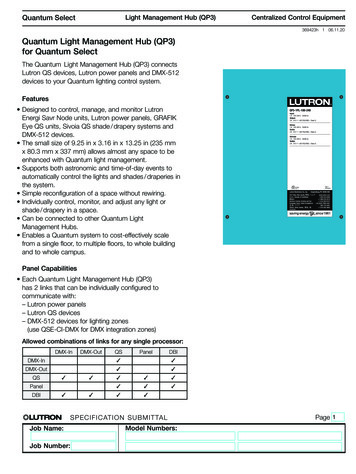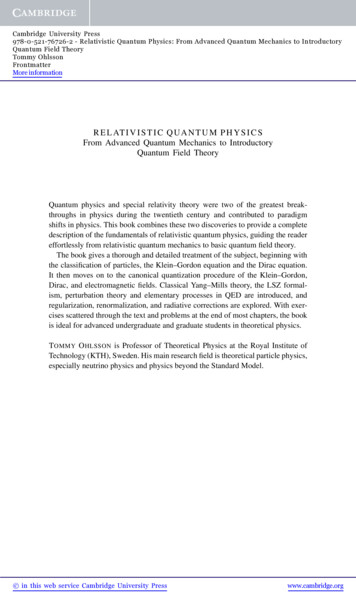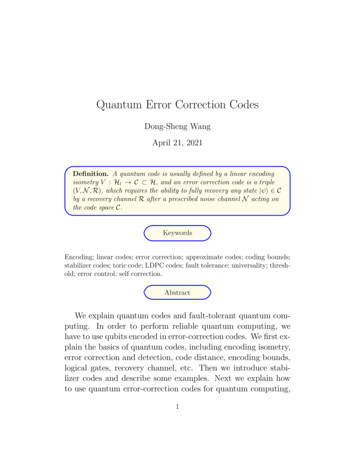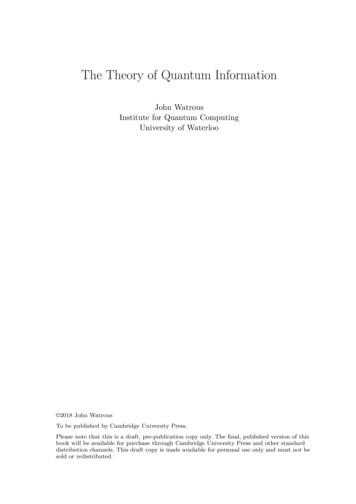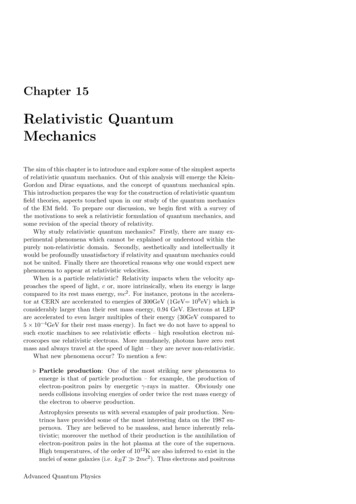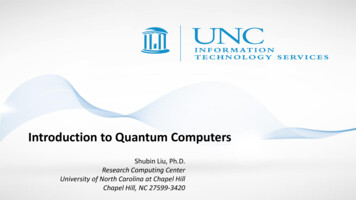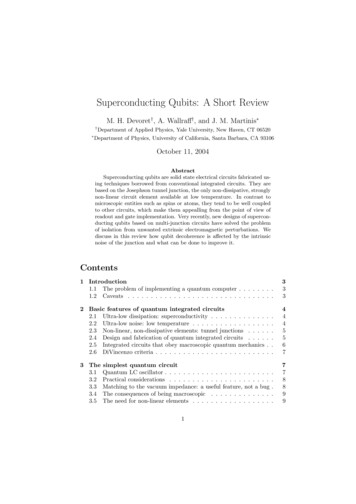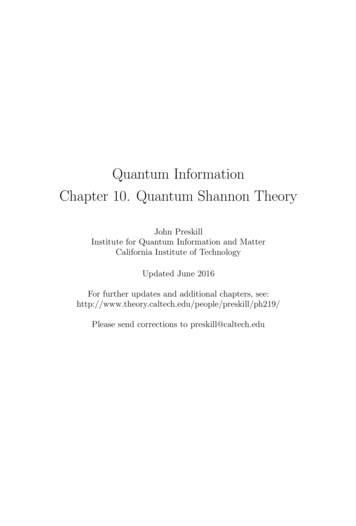
Transcription
Quantum InformationChapter 10. Quantum Shannon TheoryJohn PreskillInstitute for Quantum Information and MatterCalifornia Institute of TechnologyUpdated June 2016For further updates and additional chapters, ph219/Please send corrections to preskill@caltech.edu
Contents10Quantum Shannon Theory10.1 Shannon for Dummies10.1.1 Shannon entropy and data compression10.1.2 Joint typicality, conditional entropy, and mutual information10.1.3 Distributed source coding10.1.4 The noisy channel coding theorem10.2 Von Neumann Entropy10.2.1 Mathematical properties of H(ρ)10.2.2 Mixing, measurement, and entropy10.2.3 Strong subadditivity10.2.4 Monotonicity of mutual information10.2.5 Entropy and thermodynamics10.2.6 Bekenstein’s entropy bound.10.2.7 Entropic uncertainty relations10.3 Quantum Source Coding10.3.1 Quantum compression: an example10.3.2 Schumacher compression in general10.4 Entanglement Concentration and Dilution10.5 Quantifying Mixed-State Entanglement10.5.1 Asymptotic irreversibility under LOCC10.5.2 Squashed entanglement10.5.3 Entanglement monogamy10.6 Accessible Information10.6.1 How much can we learn from a measurement?10.6.2 Holevo bound10.6.3 Monotonicity of Holevo χ10.6.4 Improved distinguishability through coding: an example10.6.5 Classical capacity of a quantum 051535458
Contents10.6.6 Entanglement-breaking channels10.7 Quantum Channel Capacities and Decoupling10.7.1 Coherent information and the quantum channel capacity10.7.2 The decoupling principle10.7.3 Degradable channels10.8 Quantum Protocols10.8.1 Father: Entanglement-assisted quantum communication10.8.2 Mother: Quantum state transfer10.8.3 Operational meaning of strong subadditivity10.8.4 Negative conditional entropy in thermodynamics10.9 The Decoupling Inequality10.9.1 Proof of the decoupling inequality10.9.2 Proof of the mother inequality10.9.3 Proof of the father inequality10.9.4 Quantum channel capacity revisited10.9.5 Black holes as mirrors10.10 Summary10.11 Bibliographical Notes10.12 8990939697112
This article forms one chapter of Quantum Information which will be firstpublished by Cambridge University Press.c in the Work, John Preskill, 2016NB: The copy of the Work, as displayed on this website, is a draft, prepublication copy only. The final, published version of the Work can bepurchased through Cambridge University Press and other standard distribution channels. This draft copy is made available for personal use onlyand must not be sold or re-distributed.iv
PrefaceThis is the 10th and final chapter of my book Quantum Information,based on the course I have been teaching at Caltech since 1997. An earlyversion of this chapter (originally Chapter 5) has been available on thecourse website since 1998, but this version is substantially revised andexpanded.The level of detail is uneven, as I’ve aimed to provide a gentle introduction, but I’ve also tried to avoid statements that are incorrect or obscure.Generally speaking, I chose to include topics that are both useful to knowand relatively easy to explain; I had to leave out a lot of good stuff, buton the other hand the chapter is already quite long.My version of Quantum Shannon Theory is no substitute for the morecareful treatment in Wilde’s book [1], but it may be more suitable forbeginners. This chapter contains occasional references to earlier chaptersin my book, but I hope it will be intelligible when read independently ofother chapters, including the chapter on quantum error-correcting codes.This is a working draft of Chapter 10, which I will continue to update.See the URL on the title page for further updates and drafts of otherchapters. Please send an email to preskill@caltech.edu if you notice errors.Eventually, the complete book will be published by Cambridge University Press. I hesitate to predict the publication date — they have beenfar too patient with me.v
10Quantum Shannon TheoryQuantum information science is a synthesis of three great themes of 20thcentury thought: quantum physics, computer science, and informationtheory. Up until now, we have given short shrift to the information theoryside of this trio, an oversight now to be remedied.A suitable name for this chapter might have been Quantum InformationTheory, but I prefer for that term to have a broader meaning, encompassing much that has already been presented in this book. Instead I call itQuantum Shannon Theory, to emphasize that we will mostly be occupiedwith generalizing and applying Claude Shannon’s great (classical) contributions to a quantum setting. Quantum Shannon theory has severalmajor thrusts:1. Compressing quantum information.2. Transmitting classical and quantum information through noisyquantum channels.3. Quantifying, characterizing, transforming, and using quantum entanglement.A recurring theme unites these topics — the properties, interpretation,and applications of Von Neumann entropy.My goal is to introduce some of the main ideas and tools of quantumShannon theory, but there is a lot we won’t cover. For example, wewill mostly consider information theory in an asymptotic setting, wherethe same quantum channel or state is used arbitrarily many times, thusfocusing on issues of principle rather than more practical questions aboutdevising efficient protocols.1
210 Quantum Shannon Theory10.1 Shannon for DummiesBefore we can understand Von Neumann entropy and its relevance toquantum information, we should discuss Shannon entropy and its relevance to classical information.Claude Shannon established the two core results of classical informationtheory in his landmark 1948 paper. The two central problems that hesolved were:1. How much can a message be compressed; i.e., how redundant isthe information? This question is answered by the “source codingtheorem,” also called the “noiseless coding theorem.”2. At what rate can we communicate reliably over a noisy channel;i.e., how much redundancy must be incorporated into a messageto protect against errors? This question is answered by the “noisychannel coding theorem.”Both questions concern redundancy – how unexpected is the next letterof the message, on the average. One of Shannon’s key insights was thatentropy provides a suitable way to quantify redundancy.I call this section “Shannon for Dummies” because I will try to explainShannon’s ideas quickly, minimizing distracting details. That way, I cancompress classical information theory to about 14 pages.10.1.1 Shannon entropy and data compressionA message is a string of letters, where each letter is chosen from an alphabet of k possible letters. We’ll consider an idealized setting in which themessage is produced by an “information source” which picks each letterby sampling from a probability distributionX : {x, p(x)};(10.1)that is, the letter has the valuex {0, 1, 2, . . . k 1}(10.2)with probability p(x). If the source emits an n-letter message the particular string x x1 x2 . . . xn occurs with probabilityp(x1 x2 . . . xn ) nYp(xi ).(10.3)i 1Since the letters are statistically independent, and each is produced byconsulting the same probability distribution X, we say that the letters
10.1 Shannon for Dummies3are independent and identically distributed, abbreviated i.i.d. We’ll useX n to denote the ensemble of n-letter messages in which each letter isgenerated independently by sampling from X, and x (x1 x2 . . . xn ) todenote a string of bits.Now consider long n-letter messages, n 1. We ask: is it possible tocompress the message to a shorter string of letters that conveys essentially the same information? The answer is: Yes, it’s possible, unless thedistribution X is uniformly random.If the alphabet is binary, then each letter is either 0 with probability1 p or 1 with probability p, where 0 p 1. For n very large, thelaw of large numbers tells us that typical strings will contain about n(1 p) 0’s and about np 1’s. The number of distinct strings of this form is ofnorder the binomial coefficient np, and from the Stirling approximationlog n! n log n n O(log n) we obtain n!n loglog(np)! (n(1 p))!np n log n n (np log np np n(1 p) log n(1 p) n(1 p)) nH(p),(10.4)whereH(p) p log p (1 p) log(1 p)(10.5)is the entropy function.In this derivation we used the Stirling approximation in the appropriateform for natural logarithms. But from now on we will prefer to use logarithms with base 2, which is more convenient for expressing a quantityof information in bits; thus if no base is indicated, it will be understoodthat the base is 2 unless otherwise stated. Adopting this convention inthe expression for H(p), the number of typical strings is of order 2nH(p) .To convey essentially all the information carried by a string of n bits,it suffices to choose a block code that assigns a nonnegative integer toeach of the typical strings. This block code needs to distinguish about2nH(p) messages (all occurring with nearly equal a priori probability), sowe may specify any one of the messages using a binary string with lengthonly slightly longer than nH(p). Since 0 H(p) 1 for 0 p 1, andH(p) 1 only for p 12 , the block code shortens the message for anyp 6 21 (whenever 0 and 1 are not equally probable). This is Shannon’sresult. The key idea is that we do not need a codeword for every sequenceof letters, only for the typical sequences. The probability that the actualmessage is atypical becomes negligible asymptotically, i.e., in the limitn .
410 Quantum Shannon TheorySimilar reasoning applies to the case where X samples from a k-letteralphabet. In a string of n letters, x typically occurs about np(x) times,and the number of typical strings is of ordern!Qx (np(x))!' 2 nH(X) ,(10.6)where we have again invoked the Stirling approximation and nowXH(X) p(x) log2 p(x).(10.7)xis the Shannon entropy (or simply entropy) of the ensemble X {x, p(x)}.Adopting a block code that assigns integers to the typical sequences, theinformation in a string of n letters can be compressed to about nH(X)bits. In this sense a letter x chosen from the ensemble carries, on theaverage, H(X) bits of information.It is useful to restate this reasoning more carefully using the stronglaw of large numbers, which asserts that a sample average for a randomvariable almost certainly converges to its expected value in the limit ofmany trials. If we sample from the distribution Y {y, p(y)} n times,let yi , i {1, 2, . . . , n} denote the ith sample, and letXµ[Y ] hyi y p(y)(10.8)ydenote the expected value of y. Then for any positive ε and δ there is apositive integer N such thatn1Xyi µ[Y ] δn(10.9)i 1with probability at least 1 ε for all n N . We can apply this statementto the random variable log2 p(x). Let us say that a sequence of n lettersis δ-typical if1H(X) δ log2 p(x1 x2 . . . xn ) H(X) δ;n(10.10)then the strong law of large numbers says that for any ε, δ 0 and nsufficiently large, an n-letter sequence will be δ-typical with probability 1 ε.Since each δ-typical n-letter sequence x occurs with probability p( x)satisfyingpmin 2 n(H δ) p( x) 2 n(H δ) pmax ,(10.11)
10.1 Shannon for Dummies5we may infer upper and lower bounds on the number Ntyp (ε, δ, n) of typicalsequences:XXNtyp pmin p(x) 1, Ntyp pmax p(x) 1 ε, (10.12)typical xtypical ximplies2n(H δ) Ntyp (ε, δ, n) (1 ε)2n(H δ) .(10.13)Therefore, we can encode all typical sequences using a block code withlength n(H δ) bits. That way, any message emitted by the source canbe compressed and decoded successfully as long as the message is typical;the compression procedure achieves a success probability psuccess 1 ε,no matter how the atypical sequences are decoded.What if we try to compress the message even further, say to H(X) δ 0bits per letter, where δ 0 is a constant independent of the message lengthn? Then we’ll run into trouble, because there won’t be enough codewordsto cover all the typical messages, and we won’t be able to decode thecompressed message with negligible probability of error. The probabilitypsuccess of successfully decoding the message will be bounded above by00psuccess 2n(H δ ) 2 n(H δ) ε 2 n(δ δ) ε;(10.14)0we can correctly decode only 2n(H δ ) typical messages, each occurringwith probability no higher than 2 n(H δ) ; we add ε, an upper boundon the probability of an atypical message, allowing optimistically for thepossibility that we somehow manage to decode the atypical messages correctly. Since we may choose ε and δ as small as we please, this successprobability becomes small as n , if δ 0 is a positive constant.The number of bits per letter encoding the compressed message is calledthe rate of the compression code, and we say a rate R is achievable asymptotically (as n ) if there is a sequence of codes with rate at least Rand error probability approaching zero in the limit of large n. To summarize our conclusion, we have found thatCompression Rate H(X) o(1) is achievable,Compression Rate H(X) Ω(1) is not achievable,(10.15)where o(1) denotes a positive quantity which may be chosen as small aswe please, and Ω(1) denotes a positive constant. This is Shannon’s sourcecoding theorem.We have not discussed at all the details of the compression code. Wemight imagine a huge lookup table which assigns a unique codeword toeach message and vice versa, but because such a table has size exponential in n it is quite impractical for compressing and decompressing long
610 Quantum Shannon Theorymessages. It is fascinating to study how to make the coding and decodingefficient while preserving a near optimal rate of compression, and quiteimportant, too, if we really want to compress something. But this practical aspect of classical compression theory is beyond the scope of thisbook.10.1.2 Joint typicality, conditional entropy, and mutual informationThe Shannon entropy quantifies my ignorance per letter about the outputof an information source. If the source X produces an n-letter message,then n(H(X) o(1)) bits suffice to convey the content of the message,while n(H(X) Ω(1)) bits do not suffice.Two information sources X and Y can be correlated.Lettersdrawn from the sources are governed by a joint distribution XY {(x, y), p(x, y)}, in which a pair of letters (x, y) appears with probabilityp(x, y). The sources are independent if p(x, y) p(x)p(y), but correlatedotherwise. If XY is a joint distribution, we use X to denote the marginaldistribution, defined as()XX x, p(x) p(x, y) ,(10.16)yand similarly for Y . If X and Y are correlated, then by reading a messagegenerated by Y n I reduce my ignorance about a message generated by X n ,which should make it possible to compress the output of X further thanif I did not have access to Y .To make this idea more precise, we use the concept of jointly typical sequences. Sampling from the distribution X n Y n , that is, samplingn times from the joint distribution XY , produces a message ( x, y ) (x1 x2 . . . xn , y1 y2 . . . yn ) with probabilityp( x, y ) p(x1 , y1 )p(x2 , y2 ) . . . p(xn , yn ).(10.17)Let us say that ( x, y ) drawn from X n Y n is jointly δ-typical if2 n(H(X) δ) p( x) 2 n(H(X) δ) ,2 n(H(Y ) δ) p( y ) 2 n(H(Y ) δ) ,2 n(H(XY ) δ) p( x, y ) 2 n(H(XY ) δ) .(10.18)Then, applying the strong law of large numbers simultaneously to thethree distributions X n , Y n , and X n Y n , we infer that for ε, δ 0 andn sufficiently large, a sequence drawn from X n Y n will be δ-typical with
10.1 Shannon for Dummies7probability 1 ε. Using Bayes’ rule, we can then obtain upper and lowerbounds on the conditional probability p( x y ) for jointly typical sequences:2 n(H(XY ) δ)p( x, y ) n(H(Y ) δ) 2 n(H(X Y ) 2δ) ,p( y )2p( x, y )2 n(H(XY ) δ)p( x y ) n(H(Y ) δ) 2 n(H(X Y ) 2δ) .p( y )2p( x y ) (10.19)Here we have introduced the quantityH(X Y ) H(XY ) H(Y ) h log p(x, y) log p(y)i h log p(x y)i,(10.20)which is called the conditional entropy of X given Y .The conditional entropy quantifies my remaining ignorance about xonce I know y. From eq.(10.19) we see that if ( x, y ) is jointly typical(as is the case with high probability for n large), then the number ofpossible values for x compatible with the known value of y is no morethan 2n(H(X Y ) 2δ) ; hence we can convey x with a high success probabilityusing only H(X Y ) o(1) bits per letter. On the other hand we can’t0do much better, because if we use only 2n(H(X Y ) δ ) codewords, we are0limited to conveying reliably no more than a fraction 2 n(δ 2δ) of allthe jointly typical messages. To summarize, H(X Y ) is the number ofadditional bits per letter needed to specify both x and y once y is known.Similarly, H(Y X) is the number of additional bits per letter needed tospecify both x and y when x is known.The information about X that I gain when I learn Y is quantified byhow much the number of bits per letter needed to specify X is reducedwhen Y is known. Thus isI(X; Y ) H(X) H(X Y ) H(X) H(Y ) H(XY ) H(Y ) H(Y X),(10.21)which is called the mutual information. The mutual information I(X; Y )quantifies how X and Y are correlated, and is symmetric under interchange of X and Y : I find out as much about X by learning Y as about Yby learning X. Learning Y never reduces my knowledge of X, so I(X; Y )is obviously nonnegative, and indeed the inequality H(X) H(X Y ) 0follows easily from the convexity of the log function.Of course, if X and Y are completely uncorrelated, we have p(x, y) p(x)p(y), andp(x, y)I(X; Y ) log 0;(10.22)p(x)p(y)
810 Quantum Shannon Theorywe don’t find out anything about X by learning Y if there is no correlationbetween X and Y .10.1.3 Distributed source codingTo sharpen our understanding of the operational meaning of conditionalentropy, consider this situation: Suppose that the joint distribution XYis sampled n times, where Alice receives the n-letter message x and Bobreceives the n-letter message y . Now Alice is to send a message to Bobwhich will enable Bob to determine x with high success probability, andAlice wants to send as few bits to Bob as possible. This task is harderthan in the scenario considered in §10.1.2, where we assumed that theencoder and the decoder share full knowledge of y , and can choose theircode for compressing x accordingly. It turns out, though, that even inthis more challenging setting Alice can compress the message she sends toBob down to n (H(X Y ) o(1)) bits, using a method called Slepian-Wolfcoding.Before receiving ( x, y ), Alice and Bob agree to sort all the possible nletter messages that Alice might receive into 2nR possible bins of equalsize, where the choice of bins is known to both Alice and Bob. When Alicereceives x, she sends nR bits to Bob, identifying the bin that contains x.After Bob receives this message, he knows both y and the bin containing x. If there is a unique message in that bin which is jointly typical with y , Bob decodes accordingly. Otherwise, he decodes arbitrarily. This procedure can fail either because x and y are not jointly typical, or becausethere is more than one message in the bin which is jointly typical with x.Otherwise, Bob is sure to decode correctly.Since x and y are jointly typical with high probability, the compressionscheme works if it is unlikely for a bin to contain an incorrect messagewhich is jointly typical with y . If y is typical, what can we say aboutthe number Ntyp y of messages x that are jointly typical with y ? Usingeq.(10.19), we haveX1 p( x y ) Ntyp y 2 n(H(X Y ) 2δ) ,(10.23)typical x yand thusNtyp y 2n(H(X Y ) 2δ) .(10.24)Now, to estimate the probability of a decoding error, we need to specifyhow the bins are chosen. Let’s assume the bins are chosen uniformly atrandom, or equivalently, let’s consider averaging uniformly over all codesthat divide the length-n strings into 2nR bins of equal size. Then the
10.1 Shannon for Dummies9probability that a particular bin contains a message jointly typical witha specified y purely by accident is bounded above by2 nR Ntyp y 2 n(R H(X Y ) 2δ) .(10.25)We conclude that if Alice sends R bits to Bob per each letter of themessage x, whereR H(X Y ) o(1),(10.26)then the probability of a decoding error vanishes in the limit n , atleast when we average over uniformly all codes. Surely, then, there mustexist a particular sequence of codes Alice and Bob can use to achieve therate R H(X Y ) o(1), as we wanted to show.In this scenario, Alice and Bob jointly know (x, y), but initially neitherAlice nor Bob has access to all their shared information. The goal isto merge all the information on Bob’s side with minimal communicationfrom Alice to Bob, and we have found that H(X Y ) o(1) bits of communication per letter suffice for this purpose. Similarly, the informationcan be merged on Alice’s side using H(Y X) o(1) bits of communicationper letter from Bob to Alice.10.1.4 The noisy channel coding theoremSuppose Alice wants to send a message to Bob, but the communicationchannel linking Alice and Bob is noisy. Each time they use the channel,Bob receives the letter y with probability p(y x) if Alice sends the letterx. Using the channel n 1 times, Alice hopes to transmit a long messageto Bob.Alice and Bob realize that to communicate reliably despite the noisethey should use some kind of code. For example, Alice might try sendingthe same bit k times, with Bob using a majority vote of the k noisy bitshe receives to decode what Alice sent. One wonders: for a given channel,is it possible to ensure perfect transmission asymptotically, i.e., in thelimit where the number of channel uses n ? And what can be saidabout the rate of the code; that is, how many bits must be sent per letterof the transmitted message?Shannon answered these questions. He showed that any channel canbe used for perfectly reliable communication at an asymptotic nonzerorate, as long as there is some correlation between the channel’s input andits output. Furthermore, he found a useful formula for the optimal ratethat can be achieved. These results are the content of the noisy channelcoding theorem.
1010 Quantum Shannon TheoryCapacity of the binary symmetric channel. To be concrete, suppose weuse the binary alphabet {0, 1}, and the binary symmetric channel; thischannel acts on each bit independently, flipping its value with probabilityp, and leaving it intact with probability 1 p. Thus the conditionalprobabilities characterizing the channel arep(0 0) 1 p, p(0 1) p,p(1 0) p,p(1 1) 1 p.(10.27)We want to construct a family of codes with increasing block size n,such that the probability of a decoding error goes to zero as n .For each n, the code contains 2k codewords among the 2n possible stringsof length n. The rate R of the code, the number of encoded data bitstransmitted per physical bit carried by the channel, isR k.n(10.28)To protect against errors, we should choose the code so that the codewords are as “far apart” as possible. For given values of n and k, wewant to maximize the number of bits that must be flipped to change onecodeword to another, the Hamming distance between the two codewords.For any n-bit input message, we expect about np of the bits to flip — theinput diffuses into one of about 2nH(p) typical output strings, occupyingan “error sphere” of “Hamming radius” np about the input string. Todecode reliably, we want to choose our input codewords so that the errorspheres of two different codewords do not overlap substantially. Otherwise, two different inputs will sometimes yield the same output, anddecoding errors will inevitably occur. To avoid such decoding ambiguities, the total number of strings contained in all 2k 2nR error spheresshould not exceed the total number 2n of bits in the output message; wetherefore require2nH(p) 2nR 2n(10.29)orR 1 H(p) : C(p).(10.30)If transmission is highly reliable, we cannot expect the rate of the code toexceed C(p). But is the rate R C(p) actually achievable asymptotically?In fact transmission with R C o(1) and negligible decoding errorprobability is possible. Perhaps Shannon’s most ingenious idea was thatthis rate can be achieved by an average over “random codes.” Thoughchoosing a code at random does not seem like a clever strategy, rathersurprisingly it turns out that random coding achieves as high a rate asany other coding scheme in the limit n . Since C is the optimal rate
10.1 Shannon for Dummies11for reliable transmission of data over the noisy channel it is called thechannel capacity.Suppose that X is the uniformly random ensemble for a single bit (either 0 with p 12 or 1 with p 21 ), and that we sample from X n a totalof 2nR times to generate 2nR “random codewords.” The resulting codeis known by both Alice and Bob. To send nR bits of information, Alicechooses one of the codewords and sends it to Bob by using the channel ntimes. To decode the n-bit message he receives, Bob draws a “Hammingsphere” with “radius” slightly large than np, containing2n(H(p) δ)(10.31)strings. If this sphere contains a unique codeword, Bob decodes the message accordingly. If the sphere contains more than one codeword, or nocodewords, Bob decodes arbitrarily.How likely is a decoding error? For any positive δ, Bob’s decodingsphere is large enough that it is very likely to contain the codeword sentby Alice when n is sufficiently large. Therefore, we need only worry thatthe sphere might contain another codeword just by accident. Since thereare altogether 2n possible strings, Bob’s sphere contains a fractionf 2n(H(p) δ) 2 n(C(p) δ) ,2n(10.32)of all the strings. Because the codewords are uniformly random, theprobability that Bob’s sphere contains any particular codeword aside fromthe one sent by Alice is f , and the probability that the sphere containsany one of the 2nR 1 invalid codewords is no more than2nR f 2 n(C(p) R δ) .(10.33)Since δ may be as small as we please, we may choose R C(p) c where cis any positive constant, and the decoding error probability will approachzero as n .When we speak of codes chosen at random, we really mean that weare averaging over many possible codes. The argument so far has shownthat the average probability of error is small, where we average over thechoice of random code, and for each specified code we also average overall codewords. It follows that there must be a particular sequence ofcodes such that the average probability of error (when we average overthe codewords) vanishes in the limit n . We would like a strongerresult – that the probability of error is small for every codeword.To establish the stronger result, let pi denote the probability of a decoding error when codeword i is sent. For any positive ε and sufficiently
1210 Quantum Shannon Theorylarge n, we have demonstrated the existence of a code such thatnR21 X2nRpi ε.(10.34)i 1Let N2ε denote the number of codewords with pi 2ε. Then we inferthat1(N2ε )2ε ε or N2ε 2nR 1 ;(10.35)2nRwe see that we can throw away at most half of the codewords, to achievepi 2ε for every codeword. The new code we have constructed hasRate R 1,n(10.36)which approaches R as n . We have seen, then, that the rate R C(p) o(1) is asymptotically achievable with negligible probability oferror, where C(p) 1 H(p).Mutual information as an achievable rate. Now consider how to applythis random coding argument to more general alphabets and channels.The channel is characterized by p(y x), the conditional probability thatthe letter y is received when the letter x is sent. We fix an ensemble X {x, p(x)} for the input letters, and generate the codewords for a length-ncode with rate R by sampling 2nR times from the distribution X n ; thecode is known by both the sender Alice and the receiver Bob. To conveyan encoded nR-bit message, one of the 2nR n-letter codewords is selectedand sent by using the channel n times. The channel acts independently onthe n letters, governed by the same conditional probability distributionp(y x) each time it is used. The input ensemble X, together with theconditional probability characterizing the channel, determines the jointensemble XY for each letter sent, and therefore the joint ensemble X n Y nfor the n uses of the channel.To define a decoding procedure, we use the notion of joint typicalityintroduced in §10.1.2. When Bob receives the n-letter output message y , he determines whether there is an n-letter input codeword x jointlytypical with y . If such x exists and is unique, Bob decodes accordingly. Ifthere is no x jointly typical with y , or more than one such x, Bob decodesarbitrarily.How likely is a decoding error? For any positive ε and δ, the ( x, y )drawn from X n Y n is jointly δ-typical with probability at least 1 ε if nis sufficiently large. Therefore, we need only worry that there might morethan one codeword jointly typical with y .
10.1 Shannon for Dummies13Suppose that Alice samples X n to generate a codeword x, which shesends to Bob using the channel n times. Then Alice samples X n a secondtime, producing another codeword x0 . With probability close to one, both y and x0 are δ-typical. But what is the probability that x0 is jointly δtypical with y ?Because the samples are independent, the probability of drawing thesetwo codewords factorizes as p( x0 , x) p( x0 )p( x), and likewise the channeloutput y when the first codeword is sent is independent of the secondchannel input x0 , so p( x0 , y ) p( x0 )p( y ). From eq.(10.18) we obtain anupper bound on the number Nj.t. of jointly δ-typical ( x, y ):Xp( x, y ) Nj.t. 2 n(H(XY ) δ) Nj.t. 2n(H(XY ) δ) .1 j.t. ( x, y)(10.37)We also know that each δ-typical x0 occurs with probability p( x0 ) 2 n(H(X) δ) a
Quantum information science is a synthesis of three great themes of 20th century thought: quantum physics, computer science, and information theory. Up until now, we have given short shrift to the information theory side of this trio, an oversight now to be remedied. A suitable name for this chapter might have been Quantum Information



